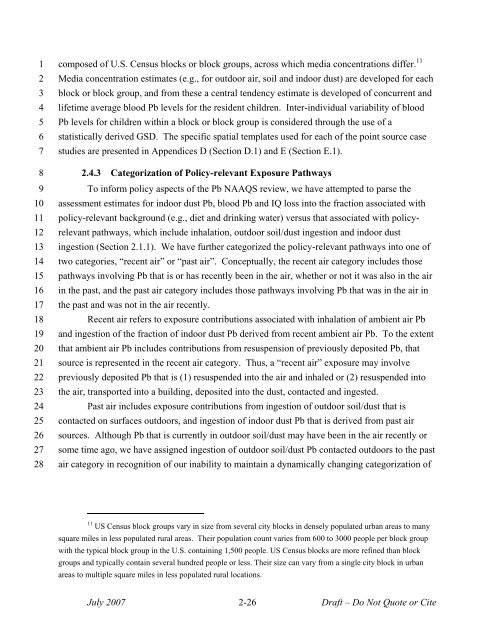Lead Human Exposure and Health Risk Assessments for Selected ...
Lead Human Exposure and Health Risk Assessments for Selected ...
Lead Human Exposure and Health Risk Assessments for Selected ...
Create successful ePaper yourself
Turn your PDF publications into a flip-book with our unique Google optimized e-Paper software.
1 composed of U.S. Census blocks or block groups, across which media concentrations differ. 11<br />
2 Media concentration estimates (e.g., <strong>for</strong> outdoor air, soil <strong>and</strong> indoor dust) are developed <strong>for</strong> each<br />
3 block or block group, <strong>and</strong> from these a central tendency estimate is developed of concurrent <strong>and</strong><br />
4 lifetime average blood Pb levels <strong>for</strong> the resident children. Inter-individual variability of blood<br />
5 Pb levels <strong>for</strong> children within a block or block group is considered through the use of a<br />
6 statistically derived GSD. The specific spatial templates used <strong>for</strong> each of the point source case<br />
7 studies are presented in Appendices D (Section D.1) <strong>and</strong> E (Section E.1).<br />
8 2.4.3 Categorization of Policy-relevant <strong>Exposure</strong> Pathways<br />
9 To in<strong>for</strong>m policy aspects of the Pb NAAQS review, we have attempted to parse the<br />
10 assessment estimates <strong>for</strong> indoor dust Pb, blood Pb <strong>and</strong> IQ loss into the fraction associated with<br />
11 policy-relevant background (e.g., diet <strong>and</strong> drinking water) versus that associated with policy<br />
12 relevant pathways, which include inhalation, outdoor soil/dust ingestion <strong>and</strong> indoor dust<br />
13 ingestion (Section 2.1.1). We have further categorized the policy-relevant pathways into one of<br />
14 two categories, “recent air” or “past air”. Conceptually, the recent air category includes those<br />
15 pathways involving Pb that is or has recently been in the air, whether or not it was also in the air<br />
16 in the past, <strong>and</strong> the past air category includes those pathways involving Pb that was in the air in<br />
17 the past <strong>and</strong> was not in the air recently.<br />
18 Recent air refers to exposure contributions associated with inhalation of ambient air Pb<br />
19 <strong>and</strong> ingestion of the fraction of indoor dust Pb derived from recent ambient air Pb. To the extent<br />
20 that ambient air Pb includes contributions from resuspension of previously deposited Pb, that<br />
21 source is represented in the recent air category. Thus, a “recent air” exposure may involve<br />
22 previously deposited Pb that is (1) resuspended into the air <strong>and</strong> inhaled or (2) resuspended into<br />
23 the air, transported into a building, deposited into the dust, contacted <strong>and</strong> ingested.<br />
24 Past air includes exposure contributions from ingestion of outdoor soil/dust that is<br />
25 contacted on surfaces outdoors, <strong>and</strong> ingestion of indoor dust Pb that is derived from past air<br />
26 sources. Although Pb that is currently in outdoor soil/dust may have been in the air recently or<br />
27 some time ago, we have assigned ingestion of outdoor soil/dust Pb contacted outdoors to the past<br />
28 air category in recognition of our inability to maintain a dynamically changing categorization of<br />
11 US Census block groups vary in size from several city blocks in densely populated urban areas to many<br />
square miles in less populated rural areas. Their population count varies from 600 to 3000 people per block group<br />
with the typical block group in the U.S. containing 1,500 people. US Census blocks are more refined than block<br />
groups <strong>and</strong> typically contain several hundred people or less. Their size can vary from a single city block in urban<br />
areas to multiple square miles in less populated rural locations.<br />
July 2007 2-26 Draft – Do Not Quote or Cite
















